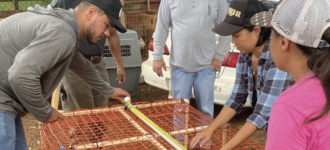Dependent on imports for more than 80% of their food, Hawaii’s people are perpetually at risk of supply chain interruptions due to natural disasters or other disruptions. Improving the capacity of local food production is one way farmers can generate income opportunities while reducing the remote islands’ risky reliance on imports.
Nicole Correa of O‘ahu’s Double D Farm and Ranch secured a Western SARE Farmer/Rancher grant to find cost-effective methods to raise broiler chickens and increase food security for Hawaii. Correa examined the influence that different forms of poultry housing had on broilers and determined that birds raised in larger cages had increased weight gain and predator protection, as well as reduced animal stress and commercial feed costs.
These results revealed an opportunity to improve the efficiency and economic sustainability of local poultry production by providing a more efficient production model.
Unfortunately, Correa also found that the lack of local poultry processing capacity in Hawaii was problematic. Though increased efficiencies were achieved while raising birds, producing the maximum number of birds allowed to be processed on-farm would have merely enabled producers to financially break even. Despite that disappointment, the innovative Hubbell Bubble Chicken Coop tested during the project has been adopted by some non-commercial producers to improve predator control in South Carolina, where Correa now works as a livestock and forages agent with Clemson University Extension.

A recent post-project evaluation of SARE projects awarded between 2016–2019 found that the farmer-friendly approach of SARE grants was essential to getting the project off the ground.“SARE is very helpful. Trying to manage a federal grant is so daunting,” says Correa. “... It gets to the point where you don’t have time to be a farmer because you’re too busy doing the paperwork. Having smaller grants available helps.”
Visit https://www.sare.org/sare-impacts-FW19-344 for more information on this project's impact.
Different Poultry Housing Options for Chickens to Determine Fastest Growing Rate is part of a series of 23 case studies produced by Insight for Action as part of a post-project evaluation of SARE's regional grant programs. Visit https://www.sare.org/sare-impacts for further details.
For information on grants and resources available from SARE, visit www.sare.org.
